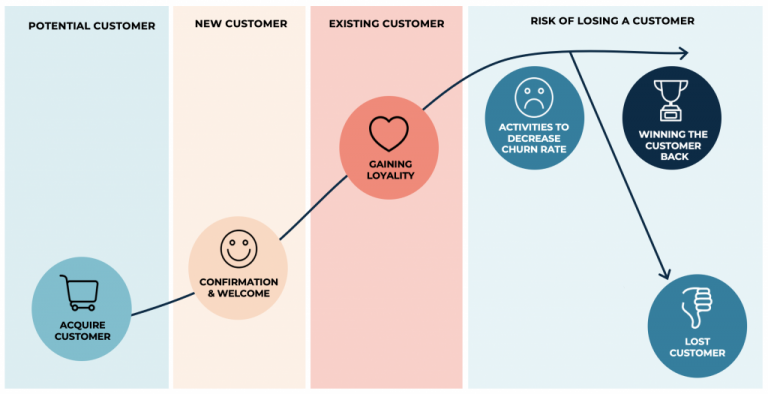
Three ways to create a better customer experience through machine learning and AI
What does AI have to do with customer experience?
When we talk about AI in this blog post, we do not speak of the human-like (or terminator kind of) intelligence which is often referred to as broad AI. But rather about so-called narrow AI, which implies data analysis and machine learning. Thus when reading forward you can think about AI as an umbrella term and machine learning as a toolbox of different methodologies that can be used to learn from data.
Nowadays the number of different channels and touchpoints each customer interacts with before making any purchase is continuously increasing. For example, we search, compare, read reviews before we buy products, and watch how-to-videos, ask questions and write reviews and comments after we have made the purchase. Google recently released a study, showing that the average number of online touchpoints before a purchase online ranged between 20 and 500 interactions. Also, there were no two identical path-to-purchases found between users. And keep in mind that these were only online interactions and clicks streams.
When we take into account all the other data that is accumulated besides online interactions, such as the purchase history of each client and interactions that happen offline e.g. calls to the call center and store visits, the amount of available data on each potential client is even larger . As the amount of data on each client increases, it is impossible for a human to deal with and utilize it optimally to serve the customer in the best possible manner. Furthermore, the expectations of potential clients are also increasing, and they expect a unified customer experience regardless of the channel they are operating in. To cope with all this, we need the help of AI and machine learning.
Customer journey model – a way to see the big picture/all key customer touchpoints
Before getting to how AI can help us in creating a better customer experience by utilizing all the data that is accumulated, we need a framework to map all the different customer interactions. As the number of customer interactions and touchpoints has exploded, it is essential for every marketer to have a framework or a model to manage the big picture. A great framework for this is to use a customer journey or a purchase journey framework. In a customer journey framework (like the one below) all the interactions are grouped based on where they are in their customer journey. Are potential customers in the phase of becoming a potential customer and researching your services/products? Or are they a new customer who has just purchased for the first time from you? Or an existing customer who is thinking about switching to your competitor? Of course, the customers’ path is not as linear as the model would suggest but knowing your customers and their path as well as possible is the basis for creating a great customer experience and efficient data-driven sales and marketing operations.

Three ways to create a better customer experience through machine learning and AI
So once we have drafted the customer journey, we can start to identify where in the customer journey we might have issues in order to create a better customer experience. To identify and tackle these issues we need assistance. This is where AI and machine learning comes into the frame. Here are three ways you can use AI as a motor for creating a better customer experience at different stages of the customer journey.
 Customer clustering for better prospecting and customer understanding
Customer clustering for better prospecting and customer understanding Algorithmic product recommendation to increase customer lifetime value
Algorithmic product recommendation to increase customer lifetime value Churn modeling to decrease churn and find core reasons for customer unhappiness
Churn modeling to decrease churn and find core reasons for customer unhappiness
1. Customer clustering to help you personalize the customer experience in an agile way
Customer clustering means grouping customers through a data analysis based on their attributes so we can understand their behavior better. The goal is to focus on the attributes that are distinctive for each cluster. Clustering is a great way to increase customer understanding as they reveal patterns in consumption and behavior. Customer clusters can help personalize both marketing communications and product/service offering to each group based on their preferences. If customer segmentation is familiar to you then clustering is an alternative way to group your customers. It is a lighter way to group your clients in comparison to a traditional segmentation survey, where you need to perform a survey, however, you do need to have good quality data. Also, we do not see customer clustering and segmentation as substitutes but as compliments. Combining customer clustering with strategic segmentation will give a comprehensive cross-section of your customers.
Customer clusters can also be utilized in marketing when you are acquiring new customers. Once the clustering is done, usually, one or two clusters come up as the most important for your business. When you have identified these, you can create look-alike audiences based on these best clusters to acquire new customers who are similar to your best existing customers. And you can personalize your marketing content based on the preferences of your existing clusters as you already know what they prefer.
2. Algorithmic product recommendation to increase customer lifetime value and customer satisfaction
When we know our customers we can recommend products and services to them that they will probably like. Product recommendation means predicting customer behavior to increase the chances of cross- and up-selling. Each customer is important and the ability to recommend products they prefer increases and enhances both customer value and customer experience.
The benefits of recommendation go beyond a simple product recommendation engine on an ecom-store. By analyzing customer transactions, we can arrange customers based on their potential for additional purchases. This data can be used to personalize user experience in different channels and in marketing communication. Further, the data can be used to analyze and predict the demand for different products which helps inventory management.
3. Churn modeling to delve into the core reasons why customers are leaving
You probably have heard the old phrase “Acquiring a new customer can cost five times more than retaining an existing customer”. Identifying churn is crucial for any business. If you are acquiring three customers and losing five at the same time, you have a problem. Well, you can stop or at least reduce churning customers by identifying churn risks and predicting churning probabilities for your customers.
If you have a high churn rate and the reasons for your customers leaving are unclear or the churning customers are spotted too late, then a churn analysis is a very useful tool for addressing the aforementioned issues. Customer churn modeling delves into the core reasons of customers churning. Once we know the reasons for customers churning, we can act accordingly. We can react to fix issues and even predict the likelihood of churning customers. If we can predict which customers are likely to churn we can focus customer satisfaction efforts directly on those customers to increase our chances of preventing churn. This kind of data gives a company a whole set of new tools to create a better customer experience, especially with customers that might be less satisfied.
Read more how our colleagues at Dagmar have reached great results with continuous customer churn analytics. Read it from here (in Finnish).
Or subscribe to our newsletter from footer to make sure you don’t miss when the case will be available in English.
Requirements for success
In order to achieve success with using AI as an enabler for better customer experience, you need to have certain fundamentals in place. We have listed these below:
 Have a clear use case in mind. What is the challenge you are trying to tackle ?
Have a clear use case in mind. What is the challenge you are trying to tackle ? Data quality & quantity. The prerequisites to utilize any advanced analytics is to have enough data and have the data quality at a good level.
Data quality & quantity. The prerequisites to utilize any advanced analytics is to have enough data and have the data quality at a good level. Sufficient systems integrations and the technological capabilities to implement the insights into actions.
Sufficient systems integrations and the technological capabilities to implement the insights into actions. Crystallizing unified goals for organization – Enhancing customer experience is not only the job of the marketing function. Once there are insights created by AI solutions, they must be implemented to create a better customer experience, and this requires the effort of the whole company.
Crystallizing unified goals for organization – Enhancing customer experience is not only the job of the marketing function. Once there are insights created by AI solutions, they must be implemented to create a better customer experience, and this requires the effort of the whole company.